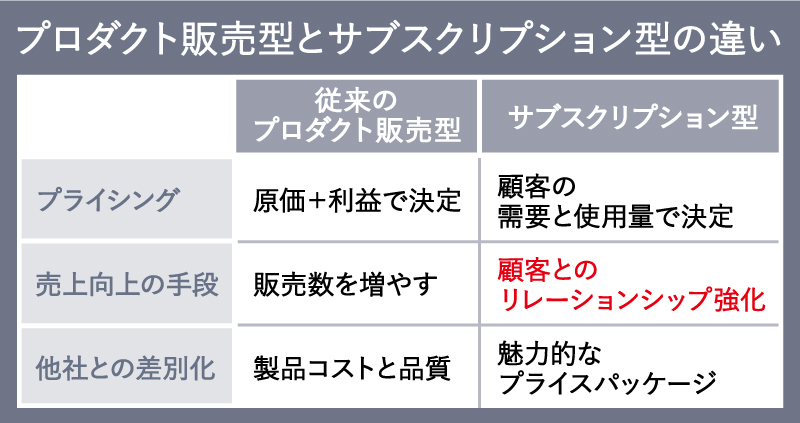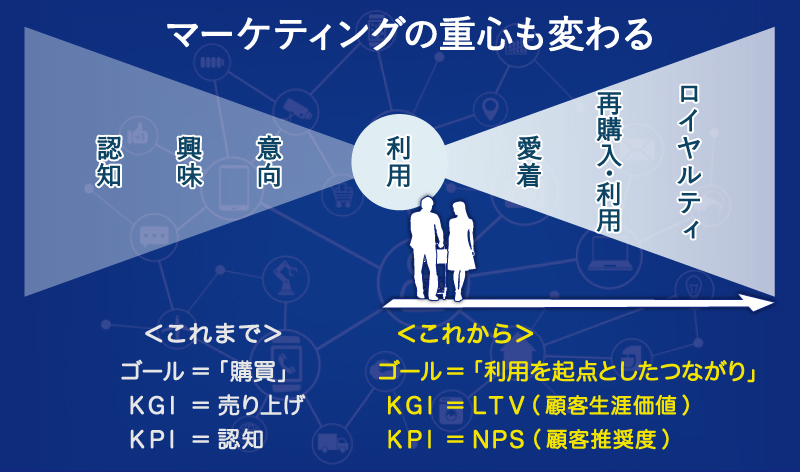From ownership to usage. Transform your business with the subscription model!

The Subscription Wave Hits "Real" Products Like Cars and Clothing
Dentsu Inc. and Dentsu Digital Inc. have formed a business partnership with Zuora Japan, a provider of subscription-based platforms to companies, launching services to support corporate business and marketing transformation through subscription-based business models.
Dentsu Inc. and Dentsu Digital Inc. Partner with Zuora Japan to Support Subscription-Based Business
http://www.dentsu.co.jp/news/release/2017/0518-009293.html
A "subscription-based business" is essentially a recurring-revenue business model. It's already commonplace for digital services like software, music, and video, so most people have heard the term.
Currently, this subscription model is poised to transform consumer purchasing behavior. It is increasingly being adopted for "non-digital" products like automobiles, clothing, cosmetics, and shavers.

The mass production model we've long been accustomed to is undergoing significant change, driven by the wave of digital transformation.
From the consumer's perspective, this represents a shift from "owning" things to a consumption style of "using" them as needed. Zuora CEO Tien Tzuo describes this global change as "the dawn of the subscription economy."

The author is responsible for developing new services and businesses at Dentsu Business Creation Center. As part of this role, working alongside Dentsu Digital Inc., they provide consulting for subscription-based businesses and oversee comprehensive implementation support for services offered by Zuora.
This column explores marketing in the subscription economy era while introducing its key characteristics.
What did Adobe gain by shifting to a subscription model?
A prime example of a subscription-based business model is Apple Music, Apple's music streaming service launched in 2015. This flat-rate, unlimited music streaming service allows users to freely listen to millions of songs. They can also download tracks they like to add to their personal library and take them on the go.
Similarly, in video streaming, services like Hulu, Netflix, and Amazon Prime Video have entered the Japanese market one after another, offering unlimited access to movies, dramas, and other video content for a flat fee. This has made such services feel increasingly familiar in Japan.
Traditionally, consuming music and videos meant purchasing physical items like CDs or DVDs. In recent years, however, a new consumption style has become widespread: paying a flat monthly fee to gain access to unlimited listening or viewing, essentially acquiring an "experience."This shift suggests a corresponding change in consumer values.
So, how does business change when shifting to a subscription model?
Adobe Systems, a major software company, changed its software sales model from product-based to subscription-based starting in the summer of 2012. They shifted to a model where users pay a fixed monthly fee for access.
This decision by a company whose products are widely used by web and video production professionals was a surprising reform to everyone in the industry. However, it ultimately contributed to an increase in new customers, who had previously been difficult to acquire, as well as overall monetization, leading to improved business performance.
Figure 1: Annual recurring revenue in the digital media sector (Adobe Systems), FY2008–FY2016

Specifically, by offering access via monthly fees rather than requiring the purchase of expensive software, Adobe was able to broaden its customer base, for example, by increasing trial opportunities. Simultaneously, providing services via the cloud enabled the company to accurately track customer usage patterns, making it possible to prompt upgrades at the optimal time.
This enabled improvements in customer satisfaction that were unattainable under a traditional, one-time product sale business model. Figure 1 shows the evolution of Adobe's annual recurring revenue (ARR) in the digital media segment. Compared to the era when it operated primarily as a product sales business, a significant improvement is evident.
According to Zuora's materials, David Wadwani, then Adobe's Senior Vice President and General Manager of Digital Media, reportedly stated something along the lines of, "We were fixated on the boxed software and completely blind to what was outside the box."

As exemplified by Adobe's business transformation, an increasing number of companies are achieving success by shifting away from selling traditional "products." They are redefining what they can offer, deepening customer relationships themselves, and enhancing the customer experience. In other words, they are succeeding by not selling "products."
How should product-selling companies respond to the changing consumer demand for "usage" tailored to individual needs, rather than "ownership"?
The 4Ps of Marketing in an "Always On" Era
With the proliferation of smartphones, consumers can now access and consume the information they want anytime.
Furthermore, as exemplified by IoT, sensors attached to various objects now enable companies to constantly collect diverse data on consumers.
Technology has transformed the relationship between consumers and businesses.
As consumers become, in a sense , "always on" through networks, the foundation of marketing is also undergoing significant change.
Traditional marketing, designed with "product purchase" as the goal, prioritized maximizing awareness and sales volume.
In contrast, the subscription-based business model, which will likely become increasingly prevalent, operates on the premise that consumers and companies are constantly "connected. " This represents a shift toward a model that aims for monetization by "ensuring consumers continue using the service, maintaining and deepening the relationship. "

Even the fundamental 4P marketing framework requires rethinking. As digitalization fosters new customer relationships, each P must now cover concepts distinct from the elements traditionally emphasized.
From products to services.
From sales to subscriptions.
From multichannel to omnichannel.
Lead generation to CRM.

In this way, the subscription-based business model, which prioritizes "customer relationships," is applicable to "all companies," regardless of industry or business type.
Below are examples of subscription-based businesses currently operating globally.
■Automotive Industry:
Services where "paying a fixed monthly amount allows unlimited use of vehicles during the contract period" are gaining prominence. There's no need to worry about taxes or insurance required when purchasing and owning a vehicle yourself. This model grants the right to drive any available vehicle, including new models, as long as it's in stock.
■Fashion & Apparel Industry:
Services that redefine how people engage with fashion items are gaining attention. Examples include rental services where professionally curated outfits by stylists or influencers are delivered regularly, and services allowing users to borrow their favorite clothes, shoes, accessories, etc., multiple times up to a specified number of items.
■Cosmetics Industry:
Paid sampling services are popular, where users register their preferences and receive monthly samples tailored to their interests. These services increase trial opportunities and help drive product purchases.
■Tire Industry:
Instead of selling tires outright, services have emerged where sensors are installed, allowing users to pay only for the mileage they drive. This lowers the barrier to purchase and also holds promise for developing new services based on usage data insights.
How to transition to a subscription-based business?
As seen with Adobe's example, shifting from a "product sales model" to a "subscription model" offers significant benefits for both companies and customers, making it worth considering. If you sense signs of change, we hope this serves as an opportunity to consider how your own business could potentially adopt a subscription model.
However, implementing and marketing a subscription model requires specific tools and expertise.
Zuora provides clients with a "subscription-based customer management & contract management system." This system enables centralized management of pricing, quoting, e-commerce, contract management, billing and collections, revenue recognition, reporting, and analytics.
The broad framework of this partnership is that Dentsu Inc. and Dentsu Digital Inc. will support the design of services—such as "what services to offer customers" and "what kind of relationship to build with customers"—along with their implementation and operation.
Next time, we'll introduce what traditional (product-selling) companies need to adopt a subscription-based business model and how to implement it, using real-world examples!
Was this article helpful?
Newsletter registration is here
We select and publish important news every day
For inquiries about this article
Author

Yokoyama Masaru
Dentsu Inc.
Joined the company in 1998. As a founding member of Dentsu Inc.'s Internet media business, he was assigned to the Cyber Advertising Department within the Multi-Channel Business Center and has consistently worked in specialized digital-related divisions ever since. From the dawn of the Internet business era, he has been involved in launching and supporting the growth of numerous new ventures in the digital domain. He currently focuses primarily on business development-related tasks. His work involves business consulting, including supporting digital domain activities, developing new markets, and assisting with sales development.
